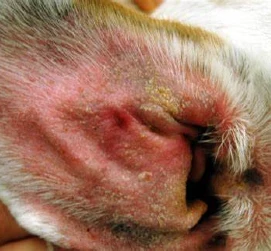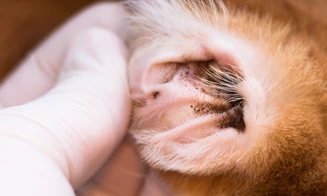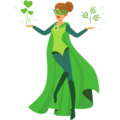Pets are more than just animals; they’re cherished members of our families. Just as we attend to our own health, it’s crucial to be vigilant about potential health issues in our furry friends.
Here’s a comprehensive look into specific health concerns that, if ignored, could escalate into more serious problems.
1. Oral Health
Tooth decay and gum disease can lead to pain, tooth loss, and difficulty eating. Bacteria from the mouth can enter the bloodstream, affecting vital organs like the heart and kidneys.
Ignoring dental health might lead to expensive surgeries or treatments for severe gum infections. Preventive dental care, including regular cleanings, is ALWAYS more affordable.
What To Look Out For:
- Reluctance to eat or difficulty chewing.
- Drooling excessively or bad breath.
- Pawing at the mouth.

Regularly inspect your pet’s teeth and gums for signs of redness, swelling, or brownish tartar.
Use pet-specific toothpaste and brush their teeth a few times a week.
Breeds Most Affected: Small dog breeds such as Poodles, Dachshunds, and Yorkshire Terriers often suffer from dental problems due to the tight spacing of their teeth.
2. Lumps and Bumps
While many growths are benign, some can be malignant tumors that can spread to other parts of the body.
Even benign lumps can grow and interfere with a pet’s mobility or organ function.
Treating malignant tumors or surgeries for larger benign tumors can be costly. Just like in people, early detection will mean less costly surgical procedures and fewer treatments.
Behaviors To Watch For:
- Licking or scratching at a specific spot more frequently. Visible discomfort or pain when the area is touched.
- Keep an eye out for anything out of the ordinary at home! When grooming or petting your animal, gently palpate their skin to check for any unfamiliar lumps or bumps.
Breeds Most Affected: Golden Retrievers, Boxers, and Rottweilers are breeds with a higher predisposition to certain types of cancers.
3. Ear Infections

Persistent infections can lead to chronic pain, hearing loss, and balance issues in both cats and dogs. Ear infections can be indicative of underlying allergies or hormonal imbalances.
Chronic infections can require extended treatments and potentially surgery. Regular cleaning and early treatment is the best way to mitigate these costs.
Things To Watch For:
- Scratching or rubbing ears excessively.
- Head shaking or tilting to one side.
- Discharge or foul odor from the ears.
Regularly check your pet’s ears for redness, swelling, or unusual discharge. Gently clean the outer ear with vet-recommended solutions.
Breeds Most Affected: Breeds with floppy ears like Cocker Spaniels, Basset Hounds, and Labrador Retrievers are more prone due to reduced air circulation in their ears.
4. Annual Check-ups
Missing a routine check-up can mean overlooking early signs of diseases.
Vaccinations can lapse, leaving pets vulnerable to preventable illnesses.
Skipping annual check-ups may lead to late diagnosis, which can be more costly in treatments and management. Regular check-ups ensure vaccinations are up-to-date, which can prevent costly treatments for preventable diseases.
Behavioral Indicators:
- Sudden weight loss or gain.
- Changes in appetite, drinking habits, or energy levels.
Keep a record of your pet’s weight, eating habits, and any behavioral changes. Share these with your vet during check-ups.
Breeds Most Affected: All breeds benefit from regular check-ups. However, some breeds with specific genetic health issues like Bulldogs, Persian cats, and German Shepherds might require more frequent monitoring.
5. Flea, Tick, and External Parasite Prevention
Many parasites can transmit diseases like Lyme disease or tapeworms. Severe infestations can lead to skin infections, anemia, or allergic reactions.
Treating skin infections or diseases transmitted by these parasites can be expensive.
Regular preventive measures like a liquid application for the skin or a pill given by mouth are cost-effective in the long run.
Watch For These Behaviors:
- Excessive scratching, biting, or licking their skin.
- Visible signs of flea dirt (black specks) or live fleas.

Regularly check your pet’s coat, especially after walks. Use a flea comb to inspect for fleas or flea dirt.
Breeds Most Affected: While all pets can be affected, breeds with thicker coats like Huskies, Malamutes, and Sheepdogs can provide a more conducive environment for parasites.
6. Heartworm and Internal Parasite Prevention
Heartworm is a parasite that is spread by mosquitos and if a pet isn’t on a monthly prevention, heartworm is deadly if untreated. It’s best to use a monthly prevention year round, even in regions where it freezes in the winter, with this disease, it’s better to be safe.
Heartworms can cause severe heart and lung disease. Internal parasites like tapeworms can lead to malnutrition, intestinal blockages, and other complications.
Treating heartworm disease is expensive and can be hard on your pet. Preventive monthly medications such as HeartGuard and Interceptor are far more affordable.
Pay Attention To The Following Behaviors:
- Fatigue after moderate activity.
- Coughing or difficulty breathing.
Monitor for signs of lethargy, especially after playtime or walks. Regularly check their stool for signs of worms or unusual consistency.
Breeds Most Affected: While heartworm disease can affect all breeds of dogs, cats are often overlooked, but they are equally susceptible to becoming infected.
7. Mites

Mites are tiny, microscopic parasites that can infest the skin of dogs, cats, and other animals and most commonly affect your dog’s or cat’s ear health. They can cause a range of skin issues depending on the species of mite and the severity of the infestation.
What To Look For:
Intense itching and scratching.
Affected areas might appear red, swollen, and inflamed.
Patchy hair loss, especially around the ears, elbows, ankles, and abdomen.
Scabs and sores.
Crusty ear discharge inside the pet’s ears.
You’ll want to identify and treat mite infestations quickly, as it can result in the formation of open sores and scabs, which are susceptible to secondary bacterial or fungal infections. And treating an advanced infection will be more expensive!
Keep in mind that mites are highly contagious among animals, so direct or even indirect contact (e.g., bedding, grooming tools) can spread them.
Breeds Most Affected: While any breed is susceptible, factors such as floppy ears like Basset Hounds, Cocker Spaniels, and Beagles and cats that spend time outdoors are more likely to contract mites.
Closing Thoughts…
With these additional insights, pet owners can be better equipped to detect early signs of health issues and understand the potential long-term financial benefits of prevention and early intervention.
Being a pet parent comes with immense joy and equally immense responsibility. By being proactive about these health concerns and understanding the specific risks associated with different breeds, you can ensure a long, healthy, and happy life for your pet.
Remember, when it comes to your pet’s health, it’s always better to err on the side of caution, animals are notorious for hiding their health issues and could be more ill than you think. Regular check-ups, immediate attention to potential problems, and preventive measures can make all the difference.
























